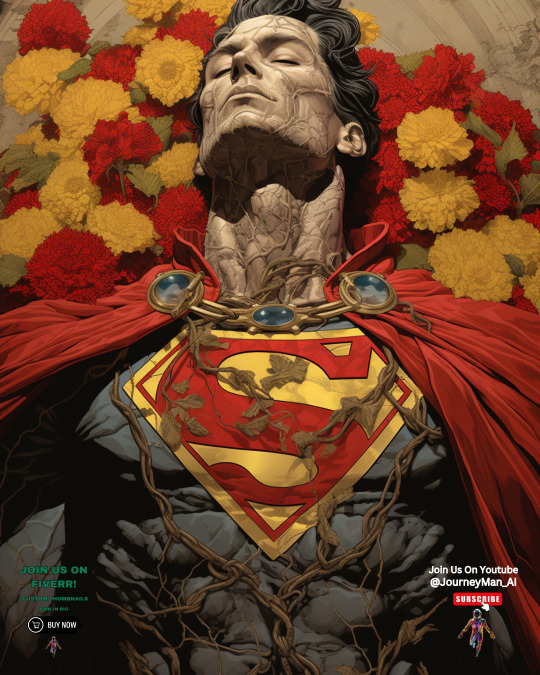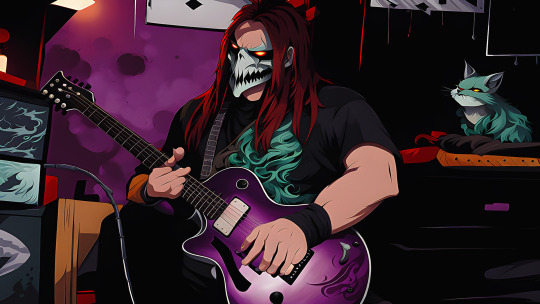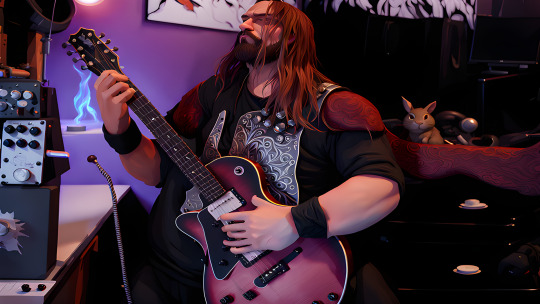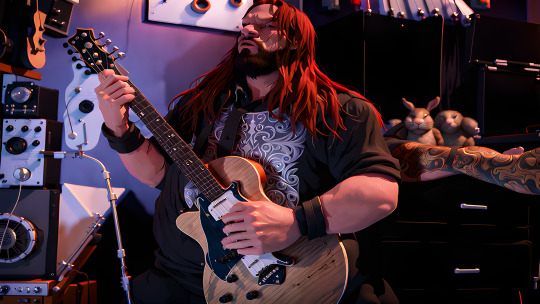#imagegeneration
Text

The Grotesque Beauty of a Deceased Superman #viral #shorts https://youtube.com/shorts/h3dqBN7Riks?si=ysdORYX6RsO5qcX9 via @YouTube
#midjourney#artificial intelligence#character design#comics#digital illustration#graphic design#ai#ai art#ai artist#ai artwork#characterdesign#characterai#GraphicDesign#midjourneyart#MidjourneyAI#AIart#AIArtwork#FiverrGig#ImageGeneration#ArtificialIntelligence#YouTube#YouTuber
27 notes
·
View notes
Text










It's Tuesday, so unless you're new around here, you know what happens now, it's time for this weeks batch of AI generated ridiculous nonsense from my most recent videos (https://youtu.be/LhI2vHFJFgo) thumbnail
This weeks idea was just "Becoming" I didn't know what I would get, but I guess I'm becoming a green and purple creature thing
2 notes
·
View notes
Text
Meet Subject-Diffusion, the model that revolutionizes open-domain personalized image generation. No test-time fine-tuning required. Just provide a text description and a reference image and get stunning single- or multi-subject images in any domain. Learn more about this model.
#AI#MachineLearning#DeepLearning#SubjectDiffusion#ImageGeneration#open source#artificial intelligence#machine learning#deep learning#data science
4 notes
·
View notes
Photo

Some dalle2 car prompt experiments. I wish I had infinite credits .... #cars #car #cardesign #design #automotivedesign #cardesignworld #cardesigndaily #cardesigncommunity #designvisual #conceptart #conceptcar #scifi #art #future #transportdesign #ai #dalle #dalle2 #imagegeneration #designinspiration #generativedesign https://www.instagram.com/p/ClZDTvqDhaD/?igshid=NGJjMDIxMWI=
#cars#car#cardesign#design#automotivedesign#cardesignworld#cardesigndaily#cardesigncommunity#designvisual#conceptart#conceptcar#scifi#art#future#transportdesign#ai#dalle#dalle2#imagegeneration#designinspiration#generativedesign
5 notes
·
View notes
Text
Top AI Image Generators in 2024
Discover top image generation tools & find your perfect creative fit in 2024. Easy interfaces, endless possibilities!
0 notes
Text
Top 4 AI Image Generators in 2024

🔝Elevate your creativity with the top 4 AI Image Generators of 2024!📆🌟
🎨 From stunning landscapes to futuristic designs, these tools are revolutionizing digital art. 🖌🖼️
🏊♂️Dive into a world where AI meets imagination and unlock endless possibilities for your visual creations.🤖🌌
🚀🔮Embrace the future of design with these cutting-edge image generators!🔪🎨
#ai#imagegenerators#digitalart#creativityunleashed#aiart#aipowered#futureofcreativity#technology#graphicdesign#designinspiration#contentcreation#artificialintelligence#imagegeneration#dreamstudio#midjourney#dalle#dalle3#adobefirefly#adobefireflybeta#adobefireflyai#dreamstudioai#midjourneyart#midjourneyai#top4#besttools#aiimagegeneration#aiimages#generatedart
0 notes
Text
Unleash Your Creativity: How to Create Images Using Bing (Free & Easy!)
Unleash your inner artist! Discover how to create images using Bing’s powerful AI tool, Bing Image Creator (formerly known as Bing Image Generator). No design skills needed! Learn everything from prompts and styles to editing and sharing. Create Images Using Bing free easy Let’s get started creating…
What is Bing Image Creator
Bing Image Creator is an AI image generator developed by Microsoft. It…

View On WordPress
#```markdown BingImageCreator#AIImageGenerator#ArtificialIntelligence#AutomatedText#BannerbearAPI#ChatGPT#Copilot#DALL-E#DigitalArt#ImageCreation#ImageEditing#ImageGeneration#ImageGenerationTips ```#ImageGeneratorTips#Microsoft#MicrosoftAccount#MicrosoftEdge#OpenAI#TextToImage#VisualStyle#How to Use Bing Image Creator: A Beginner&039;s Guide to Bing’s AI Image Generator
0 notes
Text
Embark on a linguistic adventure with Bard! Explore how Gemini Pro's global access and image generation empower you to create, learn, and express like never before. Discover exciting details, possibilities, and more!
#BardAI#GeminiPro#GlobalAccess#ImageGeneration#AIArt#Creativity#LanguageLearning#FutureofTech#ExploreWithBard
0 notes
Link
How to Use Mid-journey to Create AI Images
0 notes
Photo

In the New Museum by screenpunk
#ai#aiart#art#aiwomen#aiportret#women#hair#hairdo#popart#newart#colorful#future#futuristic#museum#aifractals#artificialintelligence#imagegeneration#midjourney#hyperrealism#unreal#imagination#visualization
0 notes
Text
The Dapper Deadpool
See Full Video Here https://youtube.com/shorts/uGkxhzYeG70?si=uodPvD30RXCmfwhw via @YouTube

#marvel#shorts#midjourney#characterdesign#GraphicDesign#midjourneyart#MidjourneyAI#AIart#AIArtwork#ImageGeneration#youtuber#superhero#viral#artificial intelligence#character design#comics#digital illustration#graphic design#ai#ai art#ai artist#ai artwork
3 notes
·
View notes
Text










It's Tuesday, so unless you're new around here, you know what happens now, it's time for this weeks batch of AI generated ridiculous nonsense from my most recent videos (https://youtu.be/h_DCqeAhbFo ) thumbnail
This weeks idea was "Chungus Among Us" and it kinda Chung-ified me
2 notes
·
View notes
Text
Unlocking Infinite Creativity: A Journey into the World of Top AI Image Generators

Are you geared up to embark on a adventure where your creativeness is aware of no bounds? Look no further than the terrific world of AI picture turbines! These innovative tools are revolutionizing the way we create and discover visible artwork. Join us as we take a closer observe the unique capabilities, blessings, and step-by way of-step guide for each of the top 10 AI picture mills. Read more
#AIImageGenerators#CreativeTech#DigitalArt#VisualInnovation#ArtificialIntelligence#TechInArt#ImaginationUnleashed#AIInDesign#GraphicDesignTools#DigitalTransformation#InnovativeCreators#AICommunity#ArtTech#ImageGeneration#VisualStorytelling#CreativeJourney#AIInspiration#ArtistryRedefined#TechandArt#VisualArts#CreativeFreedom#AIDesign#Top10AI#ArtisticExpression#CreateWithAI#DigitalCreation#InfinitePossibilities#ImaginativeTools#TechInnovation#DesignRevolution
0 notes
Text
The World of Pixel Recurrent Neural Networks (PixelRNNs)

Pixel Recurrent Neural Networks (PixelRNNs) have emerged as a groundbreaking approach in the field of image generation and processing. These sophisticated neural network architectures are reshaping how machines understand and generate visual content. This article delves into the core aspects of PixelRNNs, exploring their purpose, architecture, variants, and the challenges they face.
Purpose and Application
PixelRNNs are primarily engineered for image generation and completion tasks. Their prowess lies in understanding and generating pixel-level patterns. This makes them exceptionally suitable for tasks like image inpainting, where they fill in missing parts of an image, and super-resolution, which involves enhancing the quality of images. Moreover, PixelRNNs are capable of generating entirely new images based on learned patterns, showcasing their versatility in the realm of image synthesis.
Architecture
The architecture of PixelRNNs is built upon the principles of recurrent neural networks (RNNs), renowned for their ability to handle sequential data. In PixelRNNs, the sequence is the pixels of an image, processed in an orderly fashion, typically row-wise or diagonally. This sequential processing allows PixelRNNs to capture the intricate dependencies between pixels, which is crucial for generating coherent and visually appealing images.
Pixel-by-Pixel Generation
At the heart of PixelRNNs lies the concept of generating pixels one at a time, following a specified order. Each prediction of a new pixel is informed by the pixels generated previously, allowing the network to construct an image in a step-by-step manner. This pixel-by-pixel approach is fundamental to the network's ability to produce detailed and accurate images.
Two Variants
PixelRNNs come in two main variants: Row LSTM and Diagonal BiLSTM. The Row LSTM variant processes the image row by row, making it efficient for certain types of image patterns. In contrast, the Diagonal BiLSTM processes the image diagonally, offering a different perspective in understanding and generating image data. The choice between these two depends largely on the specific requirements of the task at hand.
Conditional Generation
A remarkable feature of PixelRNNs is their ability to be conditioned on additional information, such as class labels or parts of images. This conditioning enables the network to direct the image generation process more precisely, which is particularly beneficial for tasks like targeted image editing or generating images that need to meet specific criteria.
Training and Data Requirements
As with other neural networks, PixelRNNs require a significant volume of training data to learn effectively. They are trained on large datasets of images, where they learn to model the distribution of pixel values. This extensive training is necessary for the networks to capture the diverse range of patterns and nuances present in visual data.
Challenges and Limitations
Despite their capabilities, PixelRNNs face certain challenges and limitations. They are computationally intensive due to their sequential processing nature, which can be a bottleneck in applications requiring high-speed image generation. Additionally, they tend to struggle with generating high-resolution images, as the complexity increases exponentially with the number of pixels.
Creating a PixelRNN for image generation involves several steps, including setting up the neural network architecture and training it on a dataset of images. Here's an example in Python using TensorFlow and Keras, two popular libraries for building and training neural networks.
This example will focus on a simple PixelRNN structure using LSTM (Long Short-Term Memory) units, a common choice for RNNs. The code will outline the basic structure, but please note that for a complete and functional PixelRNN, additional components and fine-tuning are necessary.
PixRNN using TensorFlow
First, ensure you have TensorFlow installed:
pip install tensorflow
Now, let's proceed with the Python code:
import tensorflow as tf
from tensorflow.keras import layers
def build_pixel_rnn(image_height, image_width, image_channels):
# Define the input shape
input_shape = (image_height, image_width, image_channels)
# Create a Sequential model
model = tf.keras.Sequential()
# Adding LSTM layers - assuming image_height is the sequence length
# and image_width * image_channels is the feature size per step
model.add(layers.LSTM(256, return_sequences=True, input_shape=input_shape))
model.add(layers.LSTM(256, return_sequences=True))
# PixelRNNs usually have more complex structures, but this is a basic example
# Output layer - predicting the pixel values
model.add(layers.TimeDistributed(layers.Dense(image_channels, activation='softmax')))
return model
# Example parameters for a grayscale image (height, width, channels)
image_height = 64
image_width = 64
image_channels = 1 # For grayscale, this would be 1; for RGB images, it would be 3
# Build the model
pixel_rnn = build_pixel_rnn(image_height, image_width, image_channels)
# Compile the model
pixel_rnn.compile(optimizer='adam', loss='categorical_crossentropy')
# Summary of the model
pixel_rnn.summary()
This code sets up a basic PixelRNN model with two LSTM layers. The model's output is a sequence of pixel values for each step in the sequence. Remember, this example is quite simplified. In practice, PixelRNNs are more complex and may involve techniques such as masking to handle different parts of the image generation process.
Training this model requires a dataset of images, which should be preprocessed to match the input shape expected by the network. The training process involves feeding the images to the network and optimizing the weights using a loss function (in this case, categorical crossentropy) and an optimizer (Adam).
For real-world applications, you would need to expand this structure significantly, adjust hyperparameters, and possibly integrate additional features like convolutional layers or different RNN structures, depending on the specific requirements of your task.
Recent Developments
Over time, the field of PixelRNNs has seen significant advancements. Newer architectures, such as PixelCNNs, have been developed, offering improvements in computational efficiency and the quality of generated images. These developments are indicative of the ongoing evolution in the field, as researchers and practitioners continue to push the boundaries of what is possible with PixelRNNs.
Pixel Recurrent Neural Networks represent a fascinating intersection of artificial intelligence and image processing. Their ability to generate and complete images with remarkable accuracy opens up a plethora of possibilities in areas ranging from digital art to practical applications like medical imaging. As this technology continues to evolve, we can expect to see even more innovative uses and enhancements in the future.
🗒️ Sources
- dl.acm.org - Pixel recurrent neural networks - ACM Digital Library
- arxiv.org - Pixel Recurrent Neural Networks
- researchgate.net - Pixel Recurrent Neural Networks
- opg.optica.org - Single-pixel imaging using a recurrent neural network
- codingninjas.com - Pixel RNN
- journals.plos.org - Recurrent neural networks can explain flexible trading of…
Read the full article
#artificialintelligence#GenerativeModels#ImageGeneration#ImageInpainting#machinelearning#Neuralnetworks#PixelCNNs#PixelRNNs#SequentialDataProcessing#Super-Resolution
0 notes
Text
Google’s SGE Enhances Conversational Search with AI-Powered Image Generation and Draft Writing Features

Google’s Search Generative Experience (SGE) is receiving a significant upgrade, introducing new capabilities that further enhance the AI-powered search feature. Starting today, users will be able to leverage SGE to generate images through prompts, a feature akin to Bing’s support for OpenAI’s DALLE-E 3. Additionally, SGE users can now create drafts within the conversational mode, offering customization options for length, tone, and more.
Rapid AI Development
The rapid-fire updates to SGE over the past few months reflect the accelerated pace of AI technology development. Previous enhancements include AI-powered summaries, definitions of unfamiliar terms, coding improvements, travel and product search features, and more.
The new AI image generation feature allows users to input prompts specifying the desired image type, such as a drawing, photo, or painting. SGE will return four results directly in the conversational experience, and users can download these images as .png files or modify the prompt for a new set. The technology behind this feature is Google’s Imagen text-to-image model.
This image generation capability is also extended to Google Image search. Users can create new images using prompts when scrolling through image search results, providing an additional tool to find the perfect image.
Tackling Inappropriate Content
Given concerns about inappropriate content generated by AI, Company has implemented strict filtering policies, limiting the new image generation feature to users aged 18 and older. Despite SGE recently opening up to teens in the U.S. (ages 13-17), Company is mindful of responsible technology use and aims to prevent the creation of harmful, misleading, or explicit images, as well as blocking content that violates its prohibited use policies for generative AI.
Acknowledging that AI tools may not be perfect, Google has made these features opt-in through Google Search Labs, with a feedback mechanism for users to report misuses or misfires. The tools include metadata in the generated files, indicating that they are AI-generated, and invisible watermarking powered by SynthID.
The other notable feature enhancement builds on SGE’s role as a writing assistant. Users can now receive different types of drafts, varying in length or tone, expanding the tool’s utility as a versatile writing assistant. Export options for both the new features include saving images to Google Drive and exporting drafts to Google Workspace apps like Gmail or Google Docs.
To Summarize
These features will roll out gradually, starting tomorrow for a percentage of SGE users and expanding to the wider user base over the coming weeks. The enhancements are available to users who have opted in to use SGE via Google Search Labs and are currently offered in English in the U.S., with potential expansions to other regions in the future.
Read More: Google developing AI tools to help journalists report the news
#GoogleSGE#AIEnhancements#ConversationalSearch#ImageGeneration#DraftWriting#AIDevelopment#ResponsibleTech#GoogleSearchLabs
0 notes